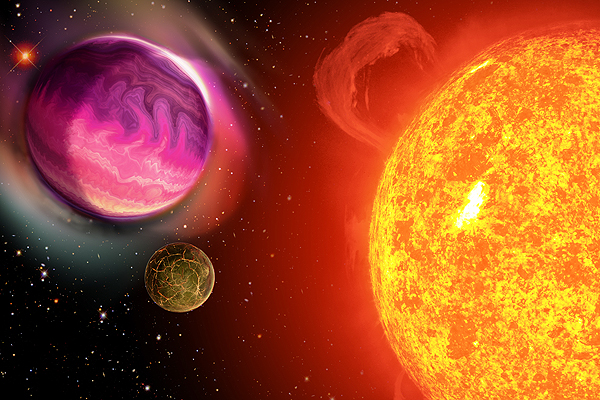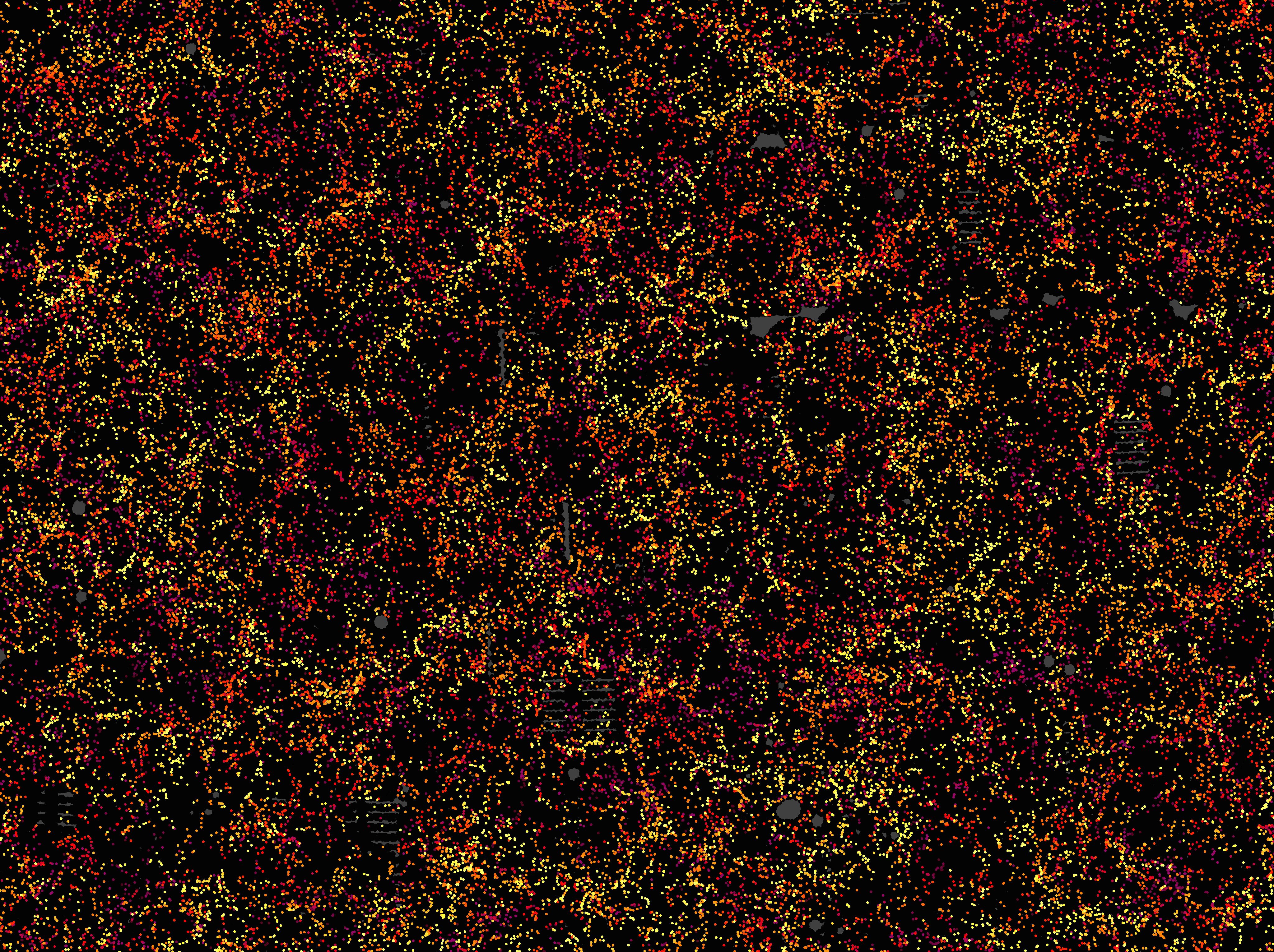The APOGEE-2 instrument team reached a significant milestone this week — the APOGEE-2 South spectrograph has begun its long journey to Chile! It is a clone of the spectrograph that is already operating on the Sloan Telescope, and will soon be operating on Carnegie Observatories’ du Pont telescope at Las Campanas Observatory. Reaching this milestone was no small feat; instrument components needed to be checked and re-checked, the spectrograph had to be meticulously packed, and it had to be transported across North America before being loaded on a ship.
El equipo de instrumentos de APOGEE-2 alcanzó un hito significativo esta semana, ¡el espectrógrafo APOGEE-2 Sur ha comenzado su largo viaje a Chile! Es un clon del espectrógrafo que ya está operando en el telescopio Sloan y pronto funcionará en el telescopio du Pont operado por los Observatorios Carnegie en el Observatorio de Las Campanas. Alcanzar este hito no fue una hazaña menor; las componentes del instrumento necesitaban ser revisadas una y otra vez, el espectrógrafo tenía que ser meticulosamente empaquetado y transportado a través de Norteamérica antes de ser cargado en un barco.
They say a picture is worth a thousand words, but frankly there is no other way but pictures to show how hard the APOGEE hardware team has been working to put all of the pieces together at the University of Virginia.
Dicen que una imagen vale más que mil palabras, pero francamente no hay otra forma que no sea usando imágenes para demostrar lo duro que el equipo de APOGEE ha estado trabajando para juntar todas las piezas en la Universidad de Virginia.
In the left-hand image below is technician Sophia Brunner. She is holding a small mirror, with which she is inspecting what is known as a v-groove block — a component that helps direct the fiber optic cables that pass light from the telescope to the spectrograph itself. On the right you can see a close-up of the v-groove block, with the v-grooves visible above Sophia’s hands. To the left of the v-grooves are channels filled with fiber-optic bundles. When the spectrograph is operational, light from individual stars will be passing through each fiber-optic cable, and so the v-groove block allows the light form each of those stars to be sent separately through the spectrograph and recorded. These fiber optics mean that APOGEE has the capability of simultaneously observing 300 stars!
En la imagen de la izquierda a continuación se encuentra la técnica Sophia Brunner. Ella sostiene un pequeño espejo con el que está inspeccionando lo que se conoce como un bloque de ranura en V, un componente que ayuda a dirigir los cables de fibra óptica por donde pasa la luz desde el telescopio al espectrógrafo. A la derecha se puede ver un primer plano del bloque de ranuras-V, con las ranuras visibles por encima de las manos de Sophia. A la izquierda de las ranuras-V se encuentran canales llenos de haces de fibra óptica. Cuando el espectrógrafo está en funcionamiento, la luz de las estrellas individuales pasará a través de cada cable de fibra óptica, por lo que el bloque de ranura en V permite que la luz de cada una de esas estrellas se envíe por separado a través del espectrógrafo para ser registradas. ¡Estas fibras ópticas significan que APOGEE tiene la capacidad de observar simultáneamente 300 estrellas!

Sophie Brunner is inspecting a v-groove block of the fiber assembly, shown in more detail at right.
Sophie Brunner está inspeccionando un bloque de ranura en V del conjunto de fibras, que se muestra con más detalle a la derecha.
How do you work with fiber optic cables? The following pictures illustrate the care and attention necessary to ensure that they do not break (fiber optics are made from glass). On the left, scientist Nick MacDonald is feeding the fiber optic cables through a feed-through in the wall of the APOGEE-2S instrument. It is sort of like feeding a thread through the eye of a needle, only in this case your “thread” can break if you try to force it. On the right, machinist Charles Lam views the 50-meter long cable conduit before fiber installation. The 300 individual fibers are bundled into ten sets of 30 in so-called long-link assemblies. The instrument-side of each long-link assembly is individually fed into the instrument and terminates at a v-groove block as shown above. After all the long-link assemblies were installed they were put into a single conduit and rolled up on a big spool.
¿Cómo trabajas con cables de fibra óptica? Las siguientes imágenes ilustran el cuidado y la atención que son necesarios para asegurar que no se rompan (las fibras ópticas están hechas de vidrio). A la izquierda, el científico Nick MacDonald está alimentando los cables de fibra óptica a través de un orificio en la pared del instrumento APOGEE-2S. Es como pasar un hilo a través del ojo de una aguja, sólo que en este caso el “hilo” puede romperse si se intenta forzarlo. A la derecha, el maquinista Charles Lam inspecciona los paquetes de cables de 50 metros de largo antes de su instalación. En esta imagen, los 300 cables individuales de fibra óptica se envuelven juntos en pequeños paquetes llamados conjuntos de enlace largo; cada conjunto de enlace largo se alimenta a través de una ranura en V individualmente, como se mostró en la imagen anterior. Después de que Charles terminó de inspeccionar los paquetes, éstos se pusieron en un sólo conducto, que posteriormente se enrolló en un gran carrete.

Nick MacDonald is threading long-link assemblies through the side wall of the spectrograph (left). Charles Lam views the conduit stretched out behind the astronomy building at UVa (right).
Nick MacDonald está enhebrando los ensambles de enlace largo a través de la pared lateral del espectrógrafo (izquierda). Charles Lam inspecciona todos los ensambles de enlace largo totalmente estirados, antes de ser agrupados en un conducto, justo afuera del edificio de astronomía en la Universidad de Virginia (derecha).
Once the fibers were in place, the instrument had to be closed up. To test that the spectrograph was working, a single fiber-optic was connected to APOGEE-2S and pointed at the Sun using a small telescope mount. The picture below of all of those happy scientists is all we need to know that the spectrograph performed to specifications.
Una vez que las fibras estuvieron en su lugar, el instrumento tenía que ser cerrado. Para probar que el espectrógrafo funcionaba, una fibra óptica fue conectada a APOGEE-2S y apuntada al Sol usando un pequeño telescopio. La imagen de abajo de estos científicos felices es todo lo que necesitamos para saber que el espectrógrafo cumplió con las especificaciones.

Professor Mike Skrutskie, along with Jimmy Davidson, Mita Tembe, Matthew Hall, and Garrett Ebelke all give the solar test a thumbs up!
El Profesor Mike Skrutskie, junto con Jimmy Davidson, Mita Tembe, Matthew Hall y Garrett Ebelke dan a la prueba solar un ¡pulgar hacia arriba!
Now it’s time to ship! The cryostat was closed, it was wrapped in a big tarp, loaded onto the delivery truck, and then driven to Pasadena, California.
¡Ahora es hora de enviar! El criostato fue cerrado, envuelto en una lona grande, cargado en el camión de la entrega y después conducido a Pasadena, California.

The APOGEE-2S instrument sits on its load cradle(left), and is carried by forklift onto the moving truck (right). El instrumento APOGEE-2S se encuentra en su cuna de carga (izquierda) y es llevado por una carretilla elevadora al camión de carga (derecha).

The APOGEE-2S instrument and accoutrements are carefully stowed (left) before the truck is closed up and drives off (right).
El instrumento APOGEE-2S y sus accesorios se guardan cuidadosamente (izquierda) antes de que el camión se cierre y comience su viaje (derecha).
Two days later, the truck arrived at the Carnegie Observatories in Pasadena, California. The spectrograph and crates were carefully unloaded and stored, awaiting the ocean shipping container, which arrived in the middle of December.
Dos días después, el camión llegó a los Observatorios Carnegie en Pasadena, California. El espectrógrafo y las cajas fueron cuidadosamente descargadas y almacenadas, esperando el contenedor de transporte marítimo, el cual llegará a mediados de diciembre.

A forklift crew unloads APOGEE-2S at the Carnegie Observatories after a successful cross-country trek. Scientist John Wilson gratefully thanks the driving team, Ludden and Gwen, for safely transporting the spectrograph.
La tripulación del montacargas descarga APOGEE-2S en los observatorios Carnegie después de un exitoso viaje. El científico John Wilson agradece al equipo de conductores, Ludden y Gwen, por transportar con seguridad el espectrógrafo.
Shipping the APOGEE-S spectrograph is a delicate business. The spectrograph has to be securely in place on the load cradle as it was in the truck, and a Shock Logger has to be placed to record any jarring movements during transportation. Below, John Wilson can be seen placing the Shock Logger on the load cradle, before the spectrograph is loaded into the shipping crate.
Transportar el espectrógrafo APOGEE-S es algo delicado. El espectrógrafo debe ser colocado cuidadosamente en su cuna de carga mientras se encuentre en el camión, así mismo se debe instalar un registrador de impactos para monitorear cualquier movimiento brusco que se produzca durante el viaje. Abajo podemos ver a John Wilson, instalando el registrador en la cuna de carga, antes de que el espectrógrafo fuera cargado.

John Wilson is mounting the Shock Logger to the APOGEE-S instrument (left). Then, John helps Greg Ortiz load APOGEE-S onto the Maersk shipping container (right).
John Wilson instala un registrador de impactos al instrumento APOGEE-S (izquierda). Más tarde John ayuda a Greg Ortiz a cargar el instrumento en el contendor (derecha).
Once the instrument is loaded onto its cargo ship in Long Beach, it will take about three weeks before it reaches San Antonio, Chile. Keep your fingers crossed for a successful last leg of the journey for APOGEE-2S!
Una vez que el instrumento suba al carguero en Long Beach, tomará alrededor de tres semanas en llegar a San Antonio, Chile.¡Mantenga sus dedos cruzados para una última etapa exitosa del viaje para APOGEE-2S!
Special thanks to Andres Meza and Mariana Cano Diaz for making this dual-language blog post possible.







![Caption: all the SDSS data are stored at the servers of the Center for High Performance Computing (CHPC[https://chpc.utah.edu/]), at the University of Utah. This particular server holds all the SDSS data releases, including DR13. The total data volume is about 267 TeraBytes (TB = 1000 Gigabyte = 1012 bytes): that is more than 58,000 DVDs worth of data! Image credit: Adam Bolton.](https://live-blog-sdssorg.pantheonsite.io/wp-content/uploads/2016/07/IMG_2029.jpeg)













